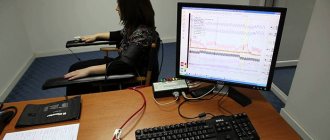Everyone in life has encountered a situation when they would like to know 100%: is a person lying or not? Alas, we are not prophets or seers, and only a few people know how to recognize lies from human behavior.
Due to the need to confirm the authenticity of the interviewee’s words, a special tool such as a polygraph . In everyday life, we call it a “lie detector.”
We will tell you in this article how such a device went from being an investigator’s tool to one of the main criteria for hiring in the largest companies.
How did the lie detector come about?
In ancient China, during the announcement of charges, the suspect was forced to take a mouthful of rice. If the grains remained dry after extraction, then the guilt was considered proven.
In India, during the “investigation”, he was given key words associated with the crime. Having heard them, the suspect had to immediately say any word that came to mind and kick the gong. At moments when the subject was lying, the gong was struck more powerfully.
At the end of the 19th century, the Italian physiologist Angelo Moss, while showing fear-inducing pictures to a patient, discovered that the subject’s heart rate increased. For these purposes, he used a plethysmograph , a device that helped determine the pulse rate.
William Marston is considered to be the true inventor of the polygraph . He devoted his life to the study of human behavior and the connection between humans and physiological processes. The topic of Marston's doctorate was the development of a test that could detect lies by measuring changes in systolic blood pressure.
What is a polygraph?
Nowadays, a polygraph or “lie detector” is a whole complex of devices consisting of:
- laptop with necessary software
- 5 – 8 sensors recording various physiological indicators
- in fact, the polygraph examiner himself, a person without whom it would be impossible to understand where the line between truth and lies is.
It is important to understand that the polygraph itself does not show anything . That is, he does not say: “This is true,” but here the person lied. It only measures biological changes in the human body.
But the answers themselves are given by a specialist polygraph examiner. And the results depend on how professional this person is.
Device diagram
A polygraph is a complex composite device consisting of several elements.
The diagram and composition of lie detector devices is as follows:
- Sensors
_ Designed to monitor and obtain data on the psychophysiological state of the human body. - COMPUTER
. A computing machine, which in most cases is represented by a desktop computer. Records and processes received data from polygraph sensors. Subsequently, the computer converts the received information into an analog code and transmits it to the output device. - Output device
. An oscilloscope, printer, or monitor screen is used as such a device. These devices display the information received by the polygraph sensors on a diagram (polygram).
The period between the moments when data is received by the sensors and displayed on the diagram lasts ~600 ms (0.6 s); in fact, data on the state of the body is displayed in real mode.
Based on the results of analyzing the information on the diagram, the specialist makes a conclusion whether the answer of the person taking the polygraph test is true or false.
How does a polygraph work?
1. Installation of sensors. The subject is asked to attach several sensors. Each of them records a certain indicator. During testing, the polygraph comprehensively controls:
- chest breathing
- diaphragmatic breathing
- skin conductivity
- heartbeat
- blood supply in peripheral vessels
- arterial pressure
- foot mat and tremor sensors
2. Brief instructions from a specialist. Before the test begins, the polygraph examiner tells you how to answer the questions.
3. Setting up and calibrating the device. To calibrate the detector, questions are asked to which the psychologist knows exactly the answers. They may ask something like: “Your name is Dmitry?”, “Are you 38 years old?” and so on.
4. Analysis of answers. Verdict. After 100 - 300 questions, the polygraph examiner begins to study the resulting graphs and draws conclusions.
Interview with a polygraph examiner
During a polygraph examination of a subject, the device clearly records changes in all physiological parameters that occur in the human body when he answers.
Then, based on the reactions received, the specialist determines which of the questions the respondent gave a false answer to. To conduct testing, it is necessary to obtain written consent of the established form from the suspect (victim, witness). But since the data obtained are probabilistic in nature, they cannot be taken into account by the court as direct evidence of guilt or innocence.
Can you trust a polygraph?
A good polygraph examiner is the key to a successful and reliable test for truth and lies. This person must have good psychological training. Why? Yes, because he must know how to put pressure on a patient.
Using a test set of questions, a polygraph examiner determines how a particular person physiologically reacts to truth and lies. Some people's breathing quickens, but their pulse remains unchanged, while for others it's the opposite.
For example, during a test the same question may be asked several times. At the same time, its semantic essence remains the same, but the subject’s brain at this moment reacts to it differently.
The polygraph examiner’s task is to respond correctly to such surges in blood pressure and pulse. That is, the exact result essentially depends on one person.
But if he is a professional, then the percentage of test reliability according to statistics is about 95 - 98% .
Where is a lie detector used?
Recently, the polygraph began to be used when applying for jobs. True, the number of potential applicants for employment in such companies drops sharply after candidates learn about the need to take a lie detector test.
But the most popular place to use lie detectors is:
- law enforcement agencies (for the purpose of interrogating suspects) - government agencies
According to statistics in Russia, almost every tenth company offers to take a lie detector test.
Of course, you can refuse such a check. True, the chances of finding a job after such a decision drop sharply. After all, you are clearly hiding something from your future superiors.
Why is the polygraph not used to solve crimes?
It would seem that if a polygraph allows you to get answers to any questions, making sure it’s true or false, why aren’t lie detectors used everywhere when investigating crimes?
The fact is that today the polygraph is positioned only as indirect evidence of guilt. And all because of such a thing as the Brokaw Trap .
This is a special case in human psychology, which appeared in terminology in 1985.
Its essence is that for some people, physiological manifestations of deception may turn out to be part of their normal behavior. A polygraph examiner can assess the behavior of such people incorrectly, thereby, to use the slang of representatives of this profession, “fall into the Brokaw trap.”
Given this, it is impossible to use the polygraph as the only reliable tool for solving crimes.
This is because a person can answer many rather complex questions with excitement. That is, if you are suspected of something that you did not do, but you are threatened with 10 - 15 years in prison, it is unlikely that when tested on a polygraph, the question “Are you guilty of a crime?” you will think directly about the answer to the question.
You will be tormented by all sorts of thoughts: about the future, about the family, about the consequences, but not about the fact that you are not involved in this. All this is recorded by a polygraph and it is possible to distinguish such nervous excitement from a true lie only after repeated repetitions of the question and scrupulous testing.
The qualifications of a polygraph examiner are most important here. This means that the sentence, in essence, will depend on one person. His mistake may cost the fate of another.
How much does a lie test cost?
Prices vary depending on the region and complexity of the inspection. As a rule, the work of a polygraph examiner is most valued when examining marital infidelity and conducting official investigations - from 7 to 15 thousand rubles. Vetting when hiring personnel is cheaper, but the price is affected by the category of the employee. Line staff can cost 3 thousand rubles, and for checking a nanny or housekeeper you will have to pay 10-15 thousand rubles. Testing teenagers is special. Not every polygraph examiner has a psychological education, and the work itself - testing a teenager on a polygraph - is not the most pleasant experience.
Is it possible to fool a polygraph?
As they say, nothing is impossible. By spending a couple of months learning and honing techniques for bypassing a polygraph, you can train your body so that the lie detector will mislead the polygraph examiner.
The essence of bypassing a polygraph is to learn to control your emotional state. And you will have to do this not only during testing, but also in everyday life. Regularly and methodically, you will have to control your emotions.
During the test you may be asked hundreds of different questions. It will take months to control yourself. Ahead lies a long period of mastering the practices of meditation and pacification of one’s own emotions.
However, deceive the polygraph in another way:
- you have a natural gift - you are a professional actor, capable of acting authentically and believing in what you play - you have a very developed sense of self-control
Finally, if you are a psychopath and do not adequately perceive reality. People suffering from nervous and mental disorders find it easy to deceive a polygraph. They simply do not understand where is real and where is fictional.
In fact, to bypass the polygraph you only need one thing - to believe that you are telling the real truth (even if it is a lie) and to be calm as a boa constrictor. But people spend years training these qualities.
And besides, do you need such a skill? If you have something to hide from yourself, then maybe you just need to reconsider your worldview?
Interpretation of polygraph test results
This is the most difficult part of testing, which is why it is so important that the specialist has the necessary knowledge and sufficient experience. In addition, many polygraph examiners are also profilers. During testing, they record a video and then watch it, processing it according to the methods of Paul Ekman (yes, the same one who acted as a consultant for the first two seasons of the series Lie to Me, starring the inimitable Tim Roth).
We hope that thanks to this publication, there are fewer dark spots in the topic of polygraph testing.
If you still have any questions, the specialists of the Verum Lie Detection Bureau will answer your questions by phone or
PS Share this material on social networks, send us a link to and receive a selection of books about psychodiagnostics and lie detection as a gift.
Drawing conclusions
1. The effectiveness of the polygraph has been proven - it really allows you to bring the average person to clean water.
2. The polygraph is rarely used in forensic science due to the presence of the human factor. The fate of a person during testing is in the hands of a polygraph examiner. But he could be wrong.
3. You can fool a polygraph, but only after months of practice and direct, regular access to the device.
4. Lie detectors are already actively used not only in law enforcement agencies, but also when applying for jobs in many reputable companies.
5. The polygraph itself does not answer questions and does not give a clear picture of where the truth is and where the lies are. He only reads physiological indicators, and the answer is given by a trained specialist - a polygraph examiner. He analyzes multiple graphs and dynamics of electromagnetic pulses taken using polygraph sensors.
(
24 votes, overall rating: 4.50 out of 5)











